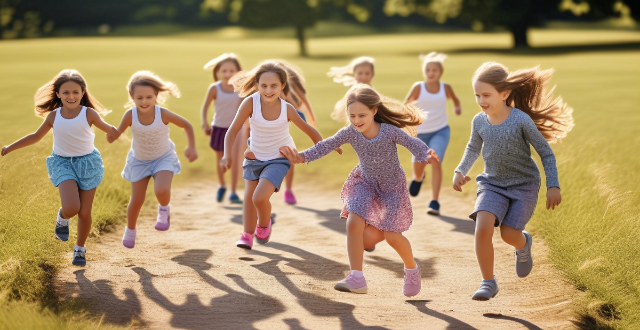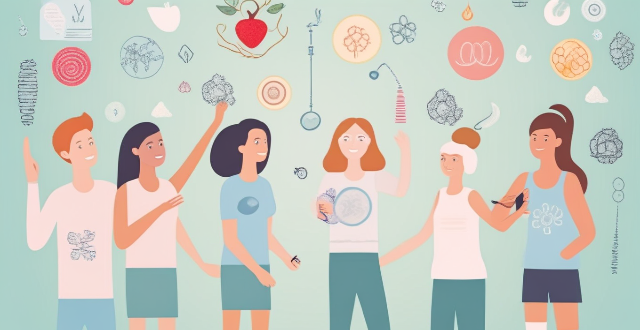Female Gender

How do gender stereotypes affect female adolescents' participation in sports ?
Gender stereotypes have a significant impact on female adolescents' participation in sports. These stereotypes can limit opportunities, discourage participation, and create barriers to success for young women in athletics. In this article, we will explore the ways in which gender stereotypes affect female adolescents' involvement in sports and discuss strategies for promoting gender equality in sports. One of the most significant ways that gender stereotypes affect female adolescents' participation in sports is by limiting their opportunities. Many schools and sports organizations still prioritize male athletes over female athletes, resulting in fewer resources and opportunities for girls to participate in sports. This can lead to a lack of access to quality coaching, training facilities, and equipment, as well as limited opportunities to compete at higher levels. Gender stereotypes also discourage female adolescents from participating in sports by perpetuating harmful beliefs about women's abilities and interests. These beliefs suggest that sports are not appropriate or desirable for girls, leading many young women to avoid athletic activities altogether. Additionally, some girls may feel pressured to conform to traditional gender roles, which often do not include participation in sports. Even when female adolescents do participate in sports, gender stereotypes can create barriers to their success. These barriers include discrimination, biased expectations, and unequal treatment compared to male athletes. For example, some coaches may have lower expectations for female athletes or provide less support and encouragement than they would for male athletes. Additionally, female athletes may face discrimination from opponents, officials, or even their own teammates. To combat the negative effects of gender stereotypes on female adolescents' participation in sports, it is essential to promote gender equality in athletics. Some strategies for achieving this goal include providing equal opportunities and resources for both male and female athletes; encouraging all students to participate in sports regardless of gender; educating coaches, parents, and peers about the benefits of sports for female adolescents; addressing discriminatory behavior and creating a culture of respect and inclusion within sports organizations; and celebrating the achievements of female athletes through media coverage and recognition events.

How has sports contributed to gender equality ?
Sports have contributed to gender equality by increasing participation, equal pay, media coverage, and female leadership in sports administration.

What are the most common challenges faced by female entrepreneurs ?
Female entrepreneurs face unique challenges, including lackFemale entrepreneurs face unique challenges, including lack funding opportunities due to gender bias limited funding opportunities due to gender bias, work-life balance issues, gender bias in the business environment, and limited support networks. Despite these obstacles, many have successfully overcome them by leveraging their strengths and building supportive networks, advocating for change within their industries.

How do gender biases affect coaching and leadership positions within sports teams and organizations ?
Gender biases in sports coaching and leadership positions manifest as discrimination against women, stereotyping of female coaches, and limited opportunities for women. These issues can be addressed by implementing diversity policies, providing mentorship programs, encouraging cultural change, and promoting transparency and accountability within sports organizations.

How do female entrepreneurship programs contribute to economic growth and gender equality ?
Female entrepreneurship programs contribute to economic growth and gender equality by providing women with resources, training, and support. They create job opportunities, diversify the economy, and generate tax revenue. These programs also address challenges faced by women in business, such as access to capital, networking, and breaking down stereotypes. Overall, they promote a more diverse and innovative economy while fostering equal opportunities for all individuals regardless of gender.

What is the role of sports sponsorship in promoting gender equality in sports ?
Sports sponsorship is crucial for promoting gender equality in sports. It provides financial support to female athletes, increases visibility of women's sports, creates role models, and promotes equity by ensuring equal funding for both men's and women's sports. This helps break down barriers and create opportunities for female athletes to compete at the highest levels.

Can you explain the concept of gender gap in education ?
The gender gap in education refers to the disparity in educational opportunities, outcomes, and achievements between males and females. It encompasses various aspects of the education system, including access to education, quality of education, and academic performance. Girls may face cultural, social, and economic barriers to attending school, while schools may not provide adequate facilities or resources for female students. Additionally, girls tend to outperform boys in subjects such as reading and writing, while boys tend to do better in math and science. Addressing the gender gap in education requires attention and action from educators, policymakers, and society as a whole to create a more equitable and just education system.

How can male-dominated fields encourage more female participation ?
In many industries, including technology, engineering, and finance, women are underrepresented. Encouraging more female participation in these male-dominated fields is not only beneficial for diversity and inclusion but also for innovation and economic growth. Here are some strategies that can be implemented to attract and retain women in these sectors: Strategies to Encourage Female Participation: 1. Education and Outreach Programs 2. Workplace Culture and Environment 3. Policies and Practices 4. Networking and Professional Development 5. Public Awareness and Media Representation

How does gender equality affect participation in competitive sports ?
Gender equality is a fundamental human right that ensures individuals are not discriminated against based on their sex. In the realm of competitive sports, gender equality can significantly influence participation rates, access to resources, and overall opportunities for athletes. This discussion will explore how gender equality affects participation in competitive sports. The importance of gender equality in sports includes equal opportunities, media coverage and representation, financial support and sponsorship, and safety and well-being. Challenges faced due to lack of gender equality include unequal participation rates, limited career opportunities, and cultural barriers. Strategies to promote gender equality in sports include policy changes, education and awareness, and supportive infrastructure development. In conclusion, gender equality plays a crucial role in determining participation rates in competitive sports. By addressing issues such as unequal opportunities, media representation, financial support, safety concerns, and cultural barriers, we can create a more inclusive environment that encourages females to engage actively in sports. Through policy changes, educational initiatives, and supportive infrastructure development, we can promote gender equality within the world of competitive sports, ensuring that talent and passion are the only determining factors for success.

How does female leadership differ from male leadership ?
Female and male leaders exhibit distinct characteristics in communication, decision-making, management styles, emotional intelligence, and negotiation tactics. Female leaders often prioritize collaboration, consensus, and empathy, while male leaders tend to be more directive, risk-prone, and competitive. Recognizing these differences can foster diverse leadership environments that value a range of perspectives and strengths.

How can companies promote gender equality in the workplace ?
In full: Companies can promote gender equality in the workplace by implementing gender-neutral hiring practices, providing equal opportunities for advancement, ensuring equitable pay and benefits, fostering an inclusive culture, addressing harassment and discrimination, supporting women in non-traditional roles, and celebrating achievements and diversity.

In what ways do strong female characters in literature shape our perceptions of women's roles and capabilities ?
Strong female characters in literature challenge traditional gender roles and showcase the capabilities of women beyond their stereotypical representations. They inspire women readers, defy gender stereotypes, promote diverse representation, celebrate female relationships, break societal barriers, and expand horizons. These characters shape our perceptions of women's roles and capabilities and promote gender equality.

What role do sports organizations play in promoting gender equality within their leagues or competitions ?
Sports organizations have a crucial role to play in promoting gender equality within their leagues or competitions. They can ensure that all athletes, regardless of their gender, have equal opportunities to participate and succeed in sports through various measures such as ensuring equal representation, providing equal pay and prize money, creating safe and inclusive environments, promoting female athletes as role models, and offering educational programs and workshops focused on gender equality in sports. By implementing these measures, sports organizations can create a culture of respect and inclusivity while ensuring that all athletes have equal opportunities to participate and succeed in sports.

What role does mentorship play in the success of female entrepreneurs ?
Mentorship plays a crucial role in the success of female entrepreneurs, providing guidance and support that can help them navigate challenges. It offers access to experienced advice, networking opportunities, confidence building, skill development, accountability, emotional support, and insights into overcoming barriers. Seeking out a mentor can increase the chances of success for female entrepreneurs.

How does the media influence perceptions of female athletes and their abilities compared to male athletes ?
The media significantly impacts perceptions of female athletes, often reinforcing stereotypes and traditional gender roles. Disparities in coverage quantity and quality, language biases, and visual representations contribute to these perceptions. Social media also influences how female athletes are viewed, with a focus on appearance and personal life. Media outlets should strive for equality in coverage to ensure female athletes receive the recognition they deserve.

How should women behave in a mixed-gender professional environment ?
Navigating gender dynamics in a mixed-gender professional environment requires women to exhibit confidence, professionalism, and foster positive relationships with colleagues. Key guidelines include speaking up, taking credit for achievements, dressing appropriately, conducting oneself with integrity, collaborating with colleagues, networking, challenging stereotypes, seeking feedback, supporting diversity, mentoring others, staying authentic, and pursuing personal growth. By following these principles, women can thrive professionally and contribute positively to the workplace culture.

How can we use sports to promote gender equality and empower women and girls ?
Promoting gender equality and empowering women and girls through sports involves increasing visibility, ensuring fair representation, improving access and inclusivity, providing education and training, implementing policy and legislation, promoting health and wellness, encouraging economic empowerment, engaging the community, and fostering cultural change. These efforts aim to break down barriers, challenge stereotypes, and create opportunities for women and girls to thrive both on and off the field.

What are some examples of successful women athletes breaking gender stereotypes in sports ?
Throughout history, women have faced numerous challenges and stereotypes in the world of sports. However, many successful female athletes have shattered these stereotypes and paved the way for future generations of female athletes. Here are some examples: 1. Serena Williams - Tennis 2. Simone Biles - Gymnastics 3. Ronda Rousey - Mixed Martial Arts (MMA) 4. Mia Hamm - Soccer 5. Katarina Johnson-Thompson - Heptathlon

What are the key challenges faced by female-centric non-profit organizations, and how can they be overcome ?
Female-centric non-profit organizations face several key challenges, including limited funding and resources, lack of visibility and recognition, gender bias and stereotyping, limited access to technology and digital tools, and balancing advocacy and service delivery. To overcome these challenges, organizations can explore alternative funding sources, increase visibility through social media and community events, prioritize diversity and inclusion, leverage cost-effective technology solutions, and build alliances with other organizations. By addressing these challenges, female-centric non-profit organizations can effectively support women and girls and create positive change in their communities.

What is the role of a female therapist in treating women's psychological problems ?
The text discusses the role of a female therapist in treating women's psychological problems, emphasizing empathy, understanding, building trust, addressing gender-specific issues, and providing supportive interventions. The article suggests that women may feel more comfortable sharing their experiences with someone who can relate to their struggles and acknowledges the importance of validation for women who have been dismissed or minimized by others. Building trust is essential, especially for women who have experienced trauma or abuse, and creating a safe space involves establishing clear boundaries and maintaining confidentiality. Cultural sensitivity is also crucial when working with women from different backgrounds. Addressing gender-specific issues such as reproductive health concerns, body image, and trauma requires specialized treatment approaches. Providing supportive interventions like mindfulness practices and group therapy can help women connect with others and receive support from peers. Overall, the role of a female therapist is multifaceted and involves creating a safe and non-judgmental space to help women navigate their unique challenges and work towards improved mental health outcomes.

Can you identify any international sports events that have taken significant steps towards achieving gender parity among competitors ?
The text discusses the growing emphasis on achieving gender parity in sports, highlighting significant steps taken by various international sports events towards this goal. It mentions the Olympics' strides in ensuring equal participation and medal distribution for men and women, FIFA's establishment of the Women's World Cup and increased investment in women's football, tennis Grand Slams offering equal prize money and television coverage for both genders, and the Rugby World Cup's efforts to promote women's rugby and implement gender equality policies. The text concludes that these initiatives demonstrate a commitment to creating a more equitable playing field for all athletes, regardless of gender, acknowledging that there is still work to be done.

How can companies support the development of female leadership talent ?
Companies can support the development of female leadership talent by implementing a variety of strategies and programs that address the unique challenges faced by women in the workplace. Here are some key ways to foster female leadership: 1. Create a diverse and inclusive culture 2. Provide mentoring and sponsorship opportunities 3. Offer professional development programs 4. Foster a collaborative work environment 5. Set clear goals and measure success

How do male celebrities approach fashion differently from female celebrities ?
Fashion is a form of self-expression, and it's an industry that both male and female celebrities have taken very seriously. However, the way they approach fashion can often differ significantly. Here are some key differences: 1. Female celebrities are generally more experimental with their fashion choices while male celebrities tend to be more conservative. 2. Accessories play a huge role in female celebrity fashion while male celebrities often opt for subtlety over statement pieces. 3. Red carpet events are seen as an opportunity for female celebrities to showcase their style while male celebrities tend to dress up in predictable outfits like tuxedos and well-tailored suits. 4. Female celebrities are more likely to collaborate with fashion brands or launch their own clothing lines while male celebrities often prefer classic styles and subtle accessories.

What are some successful examples of integrating gender equality into climate change initiatives ?
Integrating gender equality into climate change initiatives is crucial for achieving sustainable development and ensuring that everyone benefits from environmental protection measures. Successful examples include promoting women's participation in decision-making, incorporating gender perspectives into policies and programs, supporting women-led climate action initiatives, and addressing gender-based violence in climate displacement. These efforts not only promote social justice but also enhance the effectiveness of climate actions by harnessing the strengths and contributions of all individuals, regardless of their gender.

In what ways can we promote gender equality in sports for young children ?
Gender equality in sports is crucial for fairness and respect, especially among young children. To promote this, mixed-gender teams should be encouraged, equal opportunities provided, non-binary athletes supported, coaches and parents educated about gender equality, diversity celebrated, gender bias addressed, and safe spaces created for all athletes.

What are some examples of successful gender-responsive climate policies or initiatives ?
Gender-responsive climate policies and initiatives are crucial for ensuring that everyone can participate fully in efforts to mitigate and adapt to climate change. Successful examples include women's participation in renewable energy programs, gender-responsive disaster risk reduction programs, and gender-responsive agriculture and food security initiatives. These initiatives provide employment opportunities, reduce vulnerabilities, and improve agricultural practices while considering the needs and priorities of both women and men.

What are the current global challenges in achieving gender equality in education ?
Gender equality in education is a fundamental human right and key to economic growth, social development, and poverty reduction. However, several challenges hinder its achievement globally. One major challenge is the lack of access to education for girls due to poverty, cultural beliefs, and traditional roles assigned by society. Another challenge is gender bias in curriculum and teaching methods that lead to a lack of representation and role models for girls while perpetuating harmful stereotypes about gender roles. Sexual harassment and violence against girls in schools also hinder gender equality in education by creating an unsafe learning environment that can lead to low self-esteem, anxiety, depression, and dropping out of school altogether. Insufficient funding for girls' education prevents schools from providing proper facilities, materials, or trained teachers needed to support girls' learning. Addressing these challenges requires policy changes, increased funding, improved curriculum design, teacher training programs, and awareness campaigns targeting both parents and communities.

What initiatives can help reduce the gender pay gap in various industries ?
Initiatives to Reduce the Gender Pay Gap in Various Industries discusses measures that can help reduce the gender pay gap, which is a persistent issue affecting women across various industries. Reducing this gap requires a multifaceted approach that involves both government policies and private sector initiatives. Government policies include equal pay legislation, transparent salary data, family-friendly policies, women's empowerment programs, anti-discrimination laws, gender quotas, and tax incentives for companies. Private sector initiatives include internal audits, equal opportunity hiring practices, mentorship and sponsorship programs, promotion transparency, diversity training, pay negotiation workshops, performance reviews, employee resource groups, supplier diversity programs, and board diversity goals. By implementing these initiatives, both government entities and private corporations can contribute to a more equitable workplace where gender does not determine one's earnings potential. Closing the gender pay gap is crucial not only for fairness but also for unlocking the full potential of the workforce and driving economic growth.

What steps can be taken to achieve gender equality in the workplace ?
To achieve gender equality in the workplace, organizations should implement diversity policies, encourage women to apply for leadership roles, address sexual harassment, offer flexible work arrangements, and foster an inclusive culture. These steps will create a fair and diverse work environment where everyone feels valued and respected regardless of their gender identity.

How has the #MeToo movement influenced perceptions of female leadership ?
The #MeToo movement has increased awareness of gender bias and prompted changes in corporate culture, leading to greater representation of women in leadership roles. However, challenges remain in achieving true gender equality.